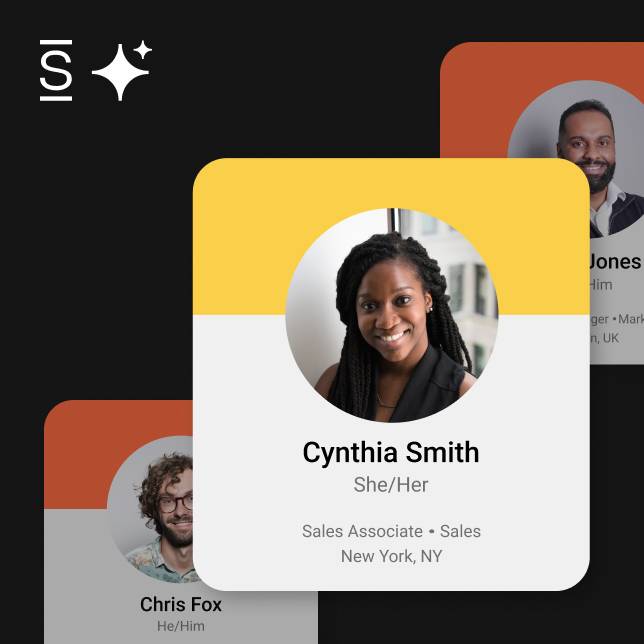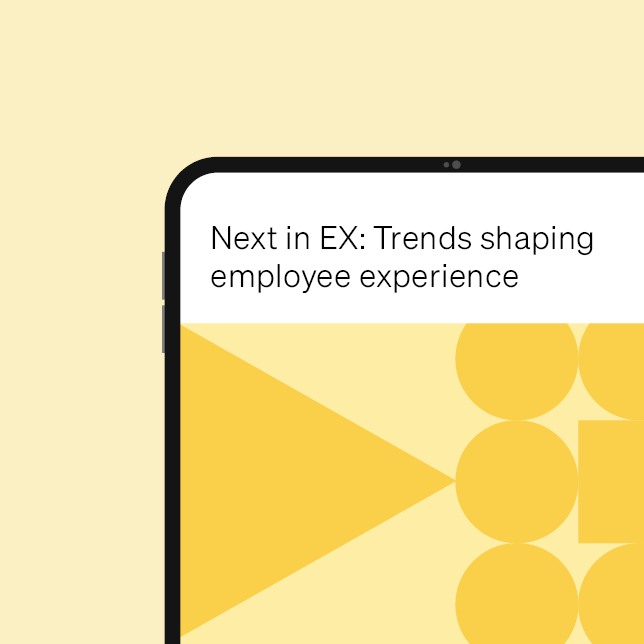We talk to Ann Melinger, owner and CEO of Brilliant Ink, an internal communication agency specializing in the design of meaningful employee experience for improved productivity and engagement. Join us to find out all about company values, and why you should be embedding these in your deskless workforce. Also, are you still apprehensive about DEI? Ann shares her thoughts on what we can do to make a difference.
The case for embedded values
Ann, leading internal communication influencer, talks a lot about company values, rather than using more conventional buzzwords like culture, and employee experience. Values, she explains, are the foundation of how a company operates and it’s really important to keep them fresh. They must be thought of as embedded in the company’s DNA, in how you work, and in how you show up. This matters, because when it comes time to make really hard decisions, and there are quite a number of these right now, it’s values that guide the making of those decisions.
Generally speaking, your company’s values shouldn’t change that much. However, if your work methods are evolving or if there are major changes in leadership, or in the business, maybe something like an acquisition, then it is important to look at refreshing them.
Typically, companies tend to refresh their values every five to ten years, but what Brilliant Ink encourages is an intentional re-visiting of values at least once a year. Ask yourselves whether these values represent where your company is today. And, importantly, do any or all of these values highlight what makes us different from our competitors?
It’s necessary to examine whether you’re doing something better than most of the other companies out there. And whether employees are demonstrating these values the moment that they walk in the door. If you’re not happy with the answers to these then it’s time to think about a refresh. We asked Ann where the internal communication role meets company values and how easy this was.
“It’s definitely an area that some communicators shy away from. They feel like it’s not in their swim lane, but communicators are the right people to talk about values because they have a finger on the employee’s pulse, understand their challenges, and know what their priorities are.”
When making a case to leadership, it’s a good idea to look around and check what your competitors are doing. If, say, competitors haven’t refreshed their values in five years, then it’s a great time for you to do it. Internal communicators are really good at listening, and that is starting point when you are sitting down to refresh your values. Talk to employees, actually show them your values.
Why values aren’t just a to-do list
When we do focus groups around values, Ann says, we put a list of values up on a screen and ask what resonates. We find out what shows up in employees’ day-to-day experience, and whether the words align with what they’re living and breathing every day at this company. We uncover values that already exist within the culture and examine what works and what doesn’t.
We asked Ann how a company’s values could stand out when so many organizations claim similar values. Values must be core to who and what a company is, but don’t have to encompass everything, she tells us. So many companies give ‘innovation’ as a value that it’s barely noticeable anymore, and it certainly won’t make you stand out. Also, she stresses, values aren’t ethics. Ethics are a basic non-negotiable, whereas values are the things you do differently, or better, than all the others out there.
So, work out what you, and your company, are at the very core, and establish four or five values based on that. At Brilliant Ink, there are 3 real, ideal values:
- Be human
- Lead the way
- Stay curious
It’s important to give some thought to the language you use to express your values. For example, we chose to use ‘be human’ instead of ‘inclusion’ because it’s more meaningful to us. Another company might feel differently about what language fits and that’s okay, because the important thing is to make sure you have the right core values and then use the right words to express those core values.
Of course, values on their own are not enough, and you have to put them into practice. We need to show what we mean via specific behaviors, and demonstrate what we mean by ‘be human’. Leaders have to show up with the right mindset, otherwise values are pretty meaningless.
Walking the walk
There’s a lot of time spent talking about companies that don’t live up to their supposed values. With all the layoffs that have been happening recently, we see a lot of companies that claim to be people-first are not people-first at all. They talk the talk, and that’s where it stops.
Ann spoke about shifting values against the backdrop of things like the pre and post-Covid-19 pandemic era and some of the social injustice incidents of recent years. We have certainly seen a trend to refresh values these last few years, she says, and there are definitely calls for help around such issues because they’re really important. They’ve made workers rethink their experiences and re-prioritize, focusing on what’s most important to them. But there are also generational changes in the workplace.
“Gen Z workers, more than others before them, want meaningful work aligned to values. If companies want to attract and retain the best young workers, they need to focus on this.”
Ann points out that establishing or refreshing your values, and expressing them, is not an expensive or arduous undertaking. It should have no bearing on the performance of the labor market or economy, and it’s something companies can do that really does make a difference.
Leaders need to live the values and make sure they permeate to all levels. It’s not a question of making a list of values and telling someone to go and launch a campaign, then walk away. Values need to be baked in, and this is where the employee life cycle comes in. You have to sit down and audit each point in the employee life cycle. Are your values showing up from when you’re recruiting new employees, and beyond?
“There needs to be a roadmap from day one to ensure your values are showing up through the entire employee life cycle.”
End-of-year reviews also need a mention here, because measuring and rewarding performance based on values is surely an impactful way to make sure that your values are being valued themselves. Because if you’re not measuring people on it, then what reason do they have to care? Thoughtful planning is needed to ensure people are thinking about values regularly, because it won’t just happen. Again, you need a plan to make it happen.
Getting by without a screen
We asked Ann about the employee experience for deskless workers and frontline people who don’t necessarily have easy access to a screen. We have to really think hard about how this person can get information, Ann says, because they work in a very different way to office employees and have totally different experiences. You have to consider whether a person, who might have been engaged in physically demanding work all day, is going to go straight to their phone at the end of the day, read a bunch of emails, and then go to the intranet.
“While I’m building a newsletter that takes them five minutes to read, I need to remember these people could be exhausted and the last thing they want to do is get on their phone and read. We have to be real with ourselves when thinking about their experience because a whole lot of other people are sending them stuff.”
If we really look carefully at the lives of frontline workers, we can see areas where we can reach them with information. Perhaps during a commute to work in the car, or when they clock into work with an app, or during the morning huddle. We need to put ourselves in their shoes and run a kind of day-in-the-life exercise.
Employee burnout and turnover are serious issues in the deskless workforce. Ann says that some studies show that, of the billions of deskless workers in the world, up to one-third are considering leaving their jobs. It’s an emotional issue because often it’s these essential workers who feel forgotten or overlooked. When these workers fall into the lower-paid levels of a sector, that’s when communications tend to be tactical or production focused. There’s not much communication around whether work is meaningful, or impactful, or whether an employee is making significant contributions to the company.
We need to remember that many of these workers, like healthcare workers, first responders and others, kept going through the Covid-19 pandemic, without any chance to work remotely. Think about all the people doing essential deliveries during that time, who just kept going on the same salary, with the same experience, and it’s not hard to understand why burnout is such a big issue.
We can’t ignore this because if one-third of our deskless workers were to quit their jobs, imagine the replacement costs. Communicators must take responsibility, and take this problem to leadership with some numbers and information on the financial risk of inaction.
“Elevate this in importance to bring it to leaders and again. It doesn’t have to be a huge change, or expensive. Let’s sit down and talk to deskless workers. Let’s understand what they want.”
Ann goes on to say that research shows, most often, that what these people really want is more in terms of learning and development. Maybe these opportunities are already offered within the company, but workers don’t understand they’re available. They need to know how to access these and take advantage of them. Companies need to equip themselves in terms of training and support to ensure they offer a great employee experience. This way communicators are motivated to take issues to leadership and to focus on deskless workers as a specific audience, with communication strategies specially tailored for them. It’s not hard, it’s not expensive, and it can really pay off.
What’s the best way to engage deskless workers?
“The number one way to reach deskless workers is through managers, because they are accessible. Managers must be equipped with the tools and resources they need, and be accountable.”
As part of a targeted communication strategy, Ann says, we must be sure to measure those managers to make sure they’re communicating effectively. Asking direct reports for feedback is vital. Very important, and it seems obvious but is frequently overlooked, is the provision of a physical space to reach those deskless workers. If there are screens available with, say, safety or production stats, maybe try using those for other information, like spotlighting employees doing great work, or those demonstrating company values’ aligned behaviors. Let workers know how their work is impactful, and tell a few stories about them.
The importance of language
We asked Ann about language, and how it factors into inclusivity when it comes to communication. Diversity, equity and inclusion (DEI) can feel scary to communicators, Anne tells us, but we all understand the power of words, and the things we say. The communications you, as an organization send out, are giving signals about what you think about inclusivity. So, if you’re using pronouns to introduce yourself, you’re sending a subtle message that this is something you think about, and everyone is welcome here. You show up how you want to show up, and we’re going to respect that.
“Small messages can be sent through the ways that you communicate, the words that you choose to use. And it must be intentional. It can’t be accidental.”
Moving the needle on DEI apprehension
Ann agrees that there’s still quite a lot of apprehension around DEI issues because there’s a sense of a right and wrong way to do things. But it’s always changing, she points out. There’s a shift and it’s an ongoing dialogue. Nothing is set in stone. On the Brilliant Ink website, the inclusive language guide is regularly updated by an in-house DEI expert. It’s important to realize though, that communicators, while they might make mistakes as sensibilities change, have their hearts in the right place. They want to nudge that needle and make a difference. Even small, incremental changes over time can move things forward and help people lose the fear.
To further boost inclusivity, Ann suggests, get into the day-to-day understanding of employees’ experience. Find out what’s important to them, and which topics matter the most. Know which channels are the most effective for communication, and follow up with regular surveys and focus groups once a year or so, if you can. If you’re reaching out to a very specific group, you might want to think about engaging, for example, an ERG representative. Also, it’s not always easy to get groups of deskless workers together in a room, so you must find a way around that by maybe doing two or three people at a time.
“Talk to them about what’s working, what’s not working, and what they need. Inclusion is really about understanding the unique experiences of people at work and making sure that we’re considering those experiences in the way we communicate.”
Ann urges us to dig deep into the results we get to make sure we’re not just making surface changes. You want to be making those changes that are getting at the things you want to accomplish, those things that make a difference. Remember, too, that actions speak louder than words, particularly in the DEI arena. We mustn’t ask questions, or ask people to share opinions on an issue and then do nothing about it. You’re better off not asking at all. Employees don’t need to hear thoughts and prayers, they want action. So, unless a company is actually doing something about an issue, they shouldn’t be out there communicating bold statements.
“Do not offend people by putting a flag over your logo if you’re not actually going to back that up in your actions and decisions.”
A word about employee experience at Brilliant Ink
Everyone knows the story of the cobbler’s children having no shoes, so we asked Ann about the employee experience at her own company. The bar is high, she explains, and it’s really important to the company that expectations are met. Employee communications are well looked after, so we can be sure we’re keeping our commitments and walking that walk, she says.
“We have an intranet, a central place owned by the entire leadership team. We look at it constantly, and it provides a focal area where people can see our values, various contacts, company holidays and much more.”
Going forward, Ann urges us to keep communicators involved in the creation, evaluation and renewal of company values. This can make a big difference in the life and health of a business, as well as shine a light on those workers overlooked or forgotten in the more traditional types of communication strategies.
Ann is passionate about Brilliant Ink’s work in employee communications and engagement, where they are able to partner with companies in the design and implementation of strategies tailored to suit their requirements.
“Given we spend so much time at work, it’s wonderful to have the privilege to influence the process toward a great organization.”
You can find out more about Ann on her website, and sign up there for her unmissable monthly newsletter. You can also get in touch with Anne, or members of the Brilliant Ink team, on LinkedIn.
If you’d like to listen to the podcast, or more of our great Cohesion podcasts, you can sign up here.

















